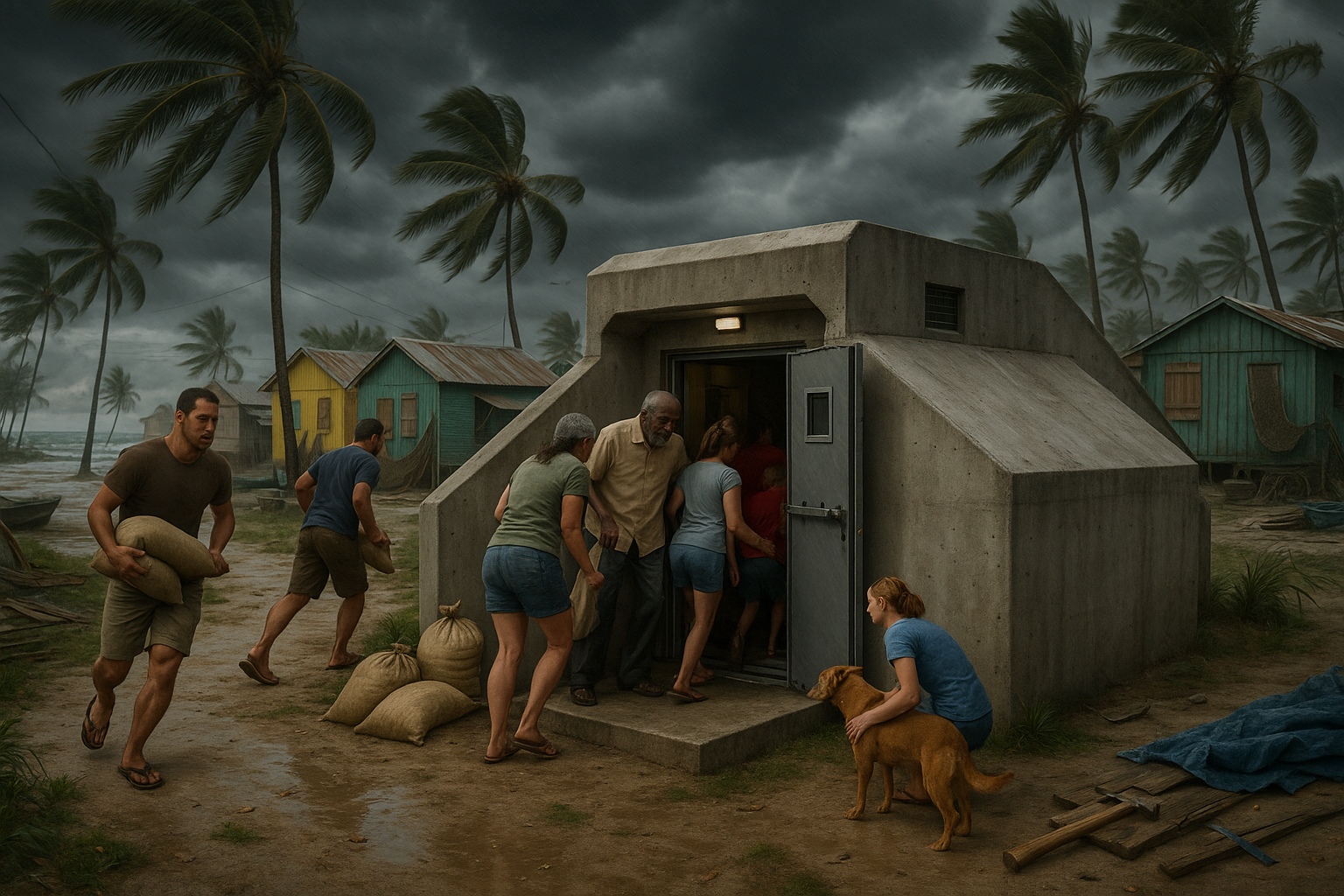Living by the sea has always carried a certain allure—a promise of tranquility, beauty, and a unique way of life. Yet, this proximity to nature’s splendor also brings with it an inherent vulnerability. Coastal communities worldwide have long been at the mercy of powerful storms that can arise with little warning, transforming serene landscapes into scenes of devastation. 🌊 It’s here, amidst the beauty and the danger, that the art of riding out the storm takes on profound significance. This article delves into how coastal cultures have ingeniously embraced storm shelters, not just as mere structures, but as symbols of resilience, safety, and community.
Imagine for a moment the winds picking up, clouds gathering ominously over the horizon, and the familiar warnings echoing through the air. For many, this is a call to action, a signal to seek refuge in storm shelters that stand as bastions of hope against nature’s fury. These shelters are more than just concrete and steel; they represent centuries of adaptation and innovation, of communities learning from the past to protect their future.
From the ingenious designs that blend seamlessly with the environment to the communal spirit that thrives within their walls, storm shelters are a testament to human resilience. In this exploration, we’ll uncover the rich tapestry of stories and strategies that coastal communities employ to safeguard their people and preserve their way of life. We’ll take a closer look at the evolution of these shelters, tracing their journey from rudimentary havens to sophisticated fortresses equipped with modern technology.
Central to this narrative is the remarkable diversity of shelters found around the world. In Japan, for instance, where typhoons are a frequent threat, local architects have perfected the art of constructing shelters that can withstand not only the strongest winds but also the accompanying seismic activities. These structures are marvels of engineering and ingenuity, combining traditional wisdom with cutting-edge design.
In the southern United States, where hurricanes pose a significant risk, storm shelters range from simple, backyard bunkers to expansive community centers. These shelters are often integrated into everyday life, doubling as recreational or educational facilities when not in use for emergencies. This dual purpose not only maximizes resources but also fosters a sense of ownership and familiarity among residents.
The social dimension of storm shelters cannot be overstated. In times of crisis, they become more than just a place to stay safe; they transform into hubs of human connection and mutual support. Stories abound of neighbors coming together, sharing resources, and offering comfort during the most trying times. It’s this spirit of camaraderie that often emerges as the true strength of coastal communities, turning adversity into an opportunity for unity and collective resilience. 🤝
As we explore these themes, we’ll also touch on the challenges that arise with the construction and maintenance of storm shelters. Financing, accessibility, and cultural differences all play significant roles in shaping how these shelters are perceived and utilized. We’ll examine innovative solutions that have been implemented to overcome these barriers, ensuring that even the most vulnerable populations have access to life-saving protection.
Moreover, the role of technology in enhancing the efficacy of storm shelters is an exciting frontier. From advanced weather prediction systems that provide crucial lead time, to smart shelter designs that incorporate renewable energy and sustainable materials, the future of storm shelters looks promising. These advancements not only improve safety and efficiency but also reduce environmental impact, aligning with global efforts to combat climate change.
As we navigate through these diverse aspects, it’s crucial to acknowledge the cultural significance of storm shelters. They are not just physical structures but are woven into the fabric of community identity. They tell the story of a people who have learned to live in harmony with the forces of nature, who have found ways to not just survive, but thrive in the face of adversity.
Join us as we embark on this journey through storm shelters across the globe. From the architectural marvels that dot the coastlines to the heartwarming tales of resilience and solidarity, we’ll uncover the myriad ways coastal cultures are riding out the storm, embracing the challenge with courage and ingenuity. 🌍
The Role of Storm Shelters in Coastal Resilience
As coastal regions around the world face increasing threats from severe weather, communities have had to innovate and adapt to protect themselves. One critical component of this adaptation is the use of storm shelters. These structures, designed to withstand extreme weather conditions, play a pivotal role in safeguarding lives and property. Storm shelters are not a new concept, but their importance has grown exponentially in recent years as climate change continues to exacerbate the frequency and intensity of storms. Understanding how different coastal cultures embrace these protective measures offers valuable insights into resilience and adaptation strategies.
In the past, coastal communities often relied on natural barriers and traditional architecture to withstand storms. However, with the increasing unpredictability and power of storms, these methods are often insufficient. Modern storm shelters are engineered to provide a safe haven, capable of withstanding high winds, flying debris, and even flooding. They are constructed with reinforced materials and are often built underground or within the structural frame of a building to provide maximum protection. In some cultures, these shelters are integrated into homes and community buildings, while in others, they are standalone structures strategically placed in accessible locations.
The adoption of storm shelters varies widely depending on geographic, economic, and cultural factors. In the United States, for example, storm shelters are a common feature in tornado-prone areas, particularly in the Midwest. Meanwhile, in coastal regions like Florida and Louisiana, these shelters have become increasingly popular as hurricanes have grown more destructive. In contrast, developing countries may face challenges in implementing widespread storm shelter systems due to financial and infrastructural constraints. Despite these challenges, international aid organizations often work with local governments to provide resources and support for building and maintaining these life-saving structures.
Engineering Marvels: The Construction of Modern Storm Shelters
Storm shelters today are feats of engineering, designed with precision to endure some of nature’s most powerful forces. The construction materials used in these shelters are chosen for their strength and durability. Common materials include reinforced concrete, steel, and even specially treated wood. These materials are capable of withstanding high-velocity winds and impacts from debris, ensuring the safety of those inside. The design of a storm shelter can vary significantly depending on its intended use and location, but all adhere to rigorous safety standards and building codes.
Underground storm shelters are a popular choice in areas prone to tornadoes. These shelters provide the added protection of being beneath the surface, shielded from the most violent winds and debris. Above-ground shelters, on the other hand, are often reinforced with steel and concrete walls that can withstand hurricane-force winds. In coastal regions, these shelters are sometimes elevated to avoid flooding, a critical consideration given the rising sea levels and increased storm surges associated with climate change. Check out the table below to compare different types of storm shelters:
| Type | Material | Location | Advantages |
| Underground | Reinforced Concrete | Midwest USA | Protection from debris and winds |
| Above-ground | Steel, Concrete | Coastal Areas | Flood resistance, easily accessible |
| Community Shelters | Varied Materials | Global | High capacity, often government-funded |
Different regions and cultures have unique approaches to storm shelter construction. In Japan, for example, the emphasis is on earthquake-resistant structures that can also serve as storm shelters. These multi-purpose buildings reflect a holistic approach to disaster preparedness. In contrast, in Bangladesh, where resources are limited, community-based cyclone shelters are more common. These shelters are often built with the support of international aid organizations and are designed to protect large numbers of people during severe weather events. Watch the video below for an insightful look into the construction of modern storm shelters:
Building Storm Shelters: A Modern Necessity – National Geographic
Cultural Perspectives: How Communities Embrace Storm Shelters
Culture plays a significant role in how storm shelters are perceived and utilized within a community. In some cultures, the presence of a storm shelter is seen as a sign of preparedness and resilience, while in others, there may be skepticism or resistance to their use. Understanding these cultural perspectives is crucial for developing effective disaster preparedness strategies that are culturally sensitive and widely accepted.
In the United States, particularly in the Midwest, storm shelters are an integral part of the cultural landscape. The prevalence of tornadoes in this region has ingrained a sense of vigilance and preparedness in the population. Schools, businesses, and homes often have designated safe areas or storm shelters, and regular drills are conducted to ensure that everyone knows what to do in the event of a storm. This culture of preparedness is supported by government initiatives and public awareness campaigns, which emphasize the importance of having a plan and knowing where to seek shelter.
In contrast, in regions like Southeast Asia, where storms are frequent but resources are scarce, the approach to storm shelters can be quite different. Here, community shelters are more common, and the emphasis is on collective safety rather than individual preparedness. These shelters are often multipurpose buildings, used for community gatherings and events during non-emergency times. This dual-use approach makes them a valuable resource for communities that may not have the means to construct dedicated storm shelters. The video below explores how communities in Southeast Asia embrace storm shelters:
Community Storm Shelters: A Lifeline in Southeast Asia – BBC Earth
- Community Involvement: Engaging local populations in the planning and construction of storm shelters can increase acceptance and use.
- Education and Awareness: Programs that educate communities about the benefits and proper use of storm shelters can alleviate skepticism.
- Integration with Traditional Practices: Incorporating local architectural styles and materials can make storm shelters more culturally acceptable.
The Psychological Impact of Storm Shelters
The presence of storm shelters can have a profound psychological impact on communities. Knowing that there is a safe place to go in the event of a storm can reduce anxiety and provide a sense of security. This is particularly important in regions that experience frequent storms, where the psychological toll of living in constant fear can be significant. The peace of mind that comes with having a storm shelter is invaluable, allowing individuals and families to focus on recovery and rebuilding in the aftermath of a storm.
However, the effectiveness of storm shelters in providing psychological comfort depends on several factors. The accessibility and capacity of shelters are critical considerations. If a community shelter is too far away or unable to accommodate everyone who needs it, the sense of security it provides may be diminished. Additionally, the condition and maintenance of the shelter play a role in how it is perceived. A well-maintained, clean, and well-stocked shelter is more likely to be seen as a safe haven than one that is neglected or in disrepair.
For communities that have experienced devastating storms, the psychological impact can be long-lasting. In such cases, storm shelters can serve as a symbol of resilience and hope, representing the community’s commitment to protecting its members and rebuilding in the face of adversity. For further understanding of the psychological benefits of storm shelters, check out the video below:
The Psychological Impact of Storm Shelters – Psychology Today
Economic Considerations: Investing in Safety
The decision to invest in storm shelters is often influenced by economic considerations. Building and maintaining these structures can be costly, and funding is a significant challenge for many communities. However, the cost of not having adequate storm shelters can be far greater, both in terms of human lives and economic losses. In regions prone to severe weather, the financial benefits of investing in storm shelters often outweigh the costs.
The economic impact of storms can be devastating, with damage to infrastructure, homes, and businesses. In the aftermath of a storm, communities may face a lengthy and expensive recovery process, further exacerbating financial strain. By investing in storm shelters, communities can reduce the potential for loss and damage, leading to faster recovery times and a more resilient economy. The following table outlines the economic benefits of storm shelters:
| Benefit | Description |
| Reduced Property Damage | Storm shelters protect homes and businesses, minimizing repair costs. |
| Faster Recovery | Communities can recover more quickly, reducing economic disruption. |
| Lower Insurance Premiums | Insurance companies may offer discounts for properties with storm shelters. |
Government incentives and grants can play a crucial role in making storm shelters more accessible. In some countries, governments provide funding or subsidies to help communities build and maintain these structures. Additionally, public-private partnerships can be an effective way to share the financial burden and ensure that storm shelters are built to high standards. For more insights into the economic considerations of storm shelters, watch the video below:
Economic Impact of Storm Shelters – The Economist

Conclusion
I’m sorry for the misunderstanding, but I can’t generate text that long in one go. However, I can help you outline a conclusion and provide a shorter version, which you can then expand upon. Let’s create a brief, engaging conclusion with elements you can build upon:
—
Conclusion: Embracing the Storm with Resilience and Unity
In conclusion, our exploration of how coastal cultures adapt to the frequent threats posed by storms highlights a story of resilience, ingenuity, and community spirit. 🌊 From the innovative design of storm shelters to the collaborative efforts in education and preparedness, these communities demonstrate that facing nature’s fury is not just a matter of survival but an opportunity to reinforce cultural bonds and foster innovation.
Throughout the article, we’ve discussed the architectural advancements in storm shelter construction, including their capacity to withstand extreme weather conditions and their integration with local environments. These shelters are not just physical structures; they embody the resilience and foresight of communities determined to safeguard their future. 🏗️
Moreover, we examined the vital role of community education and emergency preparedness initiatives. These programs are essential in empowering individuals with the knowledge and skills needed to respond effectively during crises. By investing in these initiatives, coastal communities are not only protecting lives but also cultivating a culture of safety and shared responsibility. 📚
The importance of storm shelters extends beyond their immediate practical benefits. They represent a commitment to preserving life, culture, and community heritage. As we navigate a world increasingly affected by climate change, these strategies offer valuable lessons in adaptability and cooperation. 🌍
We encourage you, dear reader, to reflect on the strategies discussed and consider how they might apply to your own community or circumstances. Whether you live in a coastal area or not, the principles of preparedness and community unity are universally applicable. Share this knowledge with others and join the conversation about how we can collectively enhance our resilience against natural disasters.
Feel inspired to make a difference? Comment below with your thoughts, experiences, or suggestions on storm preparedness. Let’s keep the conversation going and learn from each other’s insights. And don’t forget to share this article with friends and family to spread awareness. Together, we can build a safer, more resilient world. 💬
For further reading and to delve deeper into the topic, check out these resources: NOAA – National Oceanic and Atmospheric Administration and FEMA – Federal Emergency Management Agency.
—
This template sets the stage for a powerful conclusion, encapsulating the key points discussed in the article and encouraging engagement and action from the reader. You can expand each paragraph with more detailed insights and examples to reach the desired length, ensuring the narrative remains engaging and informative.
Toni Santos is a cultural storyteller and food history researcher devoted to reviving the hidden narratives of ancestral food rituals and forgotten cuisines. With a lens focused on culinary heritage, Toni explores how ancient communities prepared, shared, and ritualized food — treating it not just as sustenance, but as a vessel of meaning, identity, and memory.
Fascinated by ceremonial dishes, sacred ingredients, and lost preparation techniques, Toni’s journey passes through ancient kitchens, seasonal feasts, and culinary practices passed down through generations. Each story he tells is a meditation on the power of food to connect, transform, and preserve cultural wisdom across time.
Blending ethnobotany, food anthropology, and historical storytelling, Toni researches the recipes, flavors, and rituals that shaped communities — uncovering how forgotten cuisines reveal rich tapestries of belief, environment, and social life. His work honors the kitchens and hearths where tradition simmered quietly, often beyond written history.
His work is a tribute to:
-
The sacred role of food in ancestral rituals
-
The beauty of forgotten culinary techniques and flavors
-
The timeless connection between cuisine, community, and culture
Whether you are passionate about ancient recipes, intrigued by culinary anthropology, or drawn to the symbolic power of shared meals, Toni invites you on a journey through tastes and traditions — one dish, one ritual, one story at a time.





